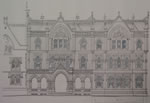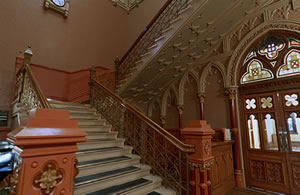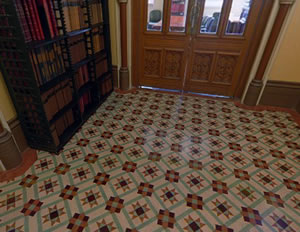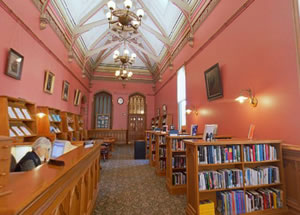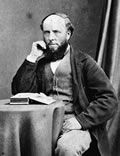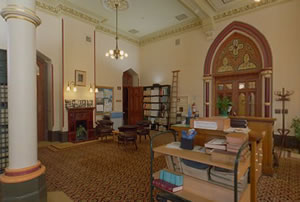The Library
Parliamentary Library. View as panorama.
Today, Parliament's library is housed in a gracious Victorian Gothic building, built in 1899 and refurbished in the early 1990s with the same colour schemes and many of the same features as a century before. For people passing Parliament's grounds, this building is a picture postcard. For MPs and others working in Parliament, the library is also an important research institution, housing many thousands of books, and important collections of newspapers and other documents relevant to the workings of Parliament.
The first libraries
In the Auckland Parliaments of the 1850s and early 1860s, the library — known as the General Assembly Library — was just a tiny room, shared with the Auckland Provincial Council. There were 750 volumes in the collection by 1860. The library moved to bigger premises in 1863, still a single-room cottage behind Parliament's main building, but this could house 4,000 volumes.
Down in Wellington from 1865, the library's holdings grew steadily: 8,000 volumes were listed in the catalogue by 1872, and housed in six substantial rooms at the rear of Parliament Buildings. Heating was provided by open fires ― lovely for reading besides of a winter's evening, but potentially hazardous for the library's contents. With the collection of newspapers and books published in New Zealand, the library became the country's premier library. The collection kept on growing, and finally flowed out into committee rooms and even the ladies' tearoom and the offices of two ministers. A new, purpose-built and fireproof building was clearly a necessity.
In Gothic Style
Today's Parliamentary Library building is a grand structure, but it could have been grander. Architect Thomas Turnbull, commissioned by Premier Richard Seddon in 1897, produced plans for an ornate three-storey structure in the Gothic style. Worries about cost led government architect John Campbell to redesign it as a two-storey building with less ornamentation. Turnbull demanded that his name be removed from the commemorative stone, but the building went up all the same and was completed in 1899.
Now there was ample room for the library's 40,000 volumes, and the collection could branch out to include paintings, photographs and documents. There were 110,000 volumes by 1926 and 300,000 40 years later.
The value of making the library fireproof became apparent just a few years after it was built. A fire destroyed the remainder of the parliamentary complex in 1907, but the library was saved by its iron fire-door. All the same, flames licked at the building, and people hurriedly carried loads of books out of the library to safety ― 8,000 in the space of 45 minutes, one newspaper reported.
Returned to Splendour
Parliamentary Library foyer and stairwell. View as panorama.
During the early 1990s the library was moved into temporary accommodation in Bowen House while the building was refurbished. This was a large and ambitious project that aimed to restore the building to its former glories, and to strengthen it in case of earthquakes. The building had also received an Historic Places Trust classification in the late 1980s for its architectural and historic significance, which helped win the argument with those who suggested it should be torn down. Three fires in 1992 disrupted the refurbishment, and the one in October seriously damaged the library, making extensive restoration work necessary.
Great care was taken in the refurbishment, and master craftsmen were engaged to work on the elaborate stained glass, and ornamental stone and plaster work. The project included recreating the nineteenth-century Lobby as the library's reception area and newspaper reading room. The buildings were reopened in late 1995.
Parliamentary Library corridor. View as panorama. The lino here was manufactured by the same firm that made the original flooring in the building nearly a century before. The heavy iron bookshelves are the original ones ordered from America in the 1890s.
Running the Library
Reading Room, Parliamentary Library. View as panorama.
The Parliamentary Library is much more than the building. It is a research institution for Parliament, a place for reading, and a storehouse of printed and other treasures.
The library got its first librarian in 1865 when Ewen McColl was made assistant librarian — although he had no one to assist — and then librarian in 1878. It was with the appointment of James Collier as librarian in 1885 that big changes were made. Collier prepared a national bibliography and opened the library to students during the parliamentary recess. He also urged the establishment of a copyright deposit in the library and saw that the library could form the basis of a national library for New Zealand. Both would be realised (in 1903 and 1966).
Guy Scholefield's appointment as Chief Librarian in 1926 brought the place into the modern era. He replaced ledgers and day-books with a card system for issues, introduced a reference service with dedicated staff, built up the newspaper collection and established an official document section. Scholefield expected his staff to have university qualifications, and the first woman, Miss Cowles, was hired. Housing an historical archive of politicians' and provincial and central government papers was added to the Chief Librarian's duties.
Librarians also prepared important publications that were of use to researchers interested in Parliament and New Zealand history. Scholefield produced a guide to local newspapers in 1937, a Dictionary of New Zealand Biography and a parliamentary record in 1940. In 1985, Chief Librarian James Wilson updated the record, which provided a comprehensive guide to MPs and government departments through Parliament's history.
The idea of a national library eventually came to fruition in 1966, although not quite as Collier had imagined back in the nineteenth century. Rather than being the basis of such a library, the General Assembly Library was swallowed up into a National Library along with the Alexander Turnbull Library and the National Library Service. It was a short-lived marriage, and the General Assembly Library was separated from the National Library in 1985. From that time, the Parliamentary Library, as it was renamed, focused itself more exclusively on serving the needs of Parliament. For the public, the Library runs the Parliament Information Service.
International Documents Room. View as panorama.
See also panoramas of the Parliamentary Library entrance and meeting room.
External links
Learn more about the Parliamentary Library and its staff on the Parliamentary Service website.
Next: Disasters >


